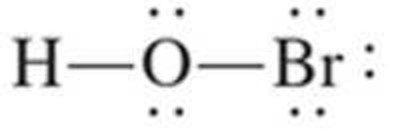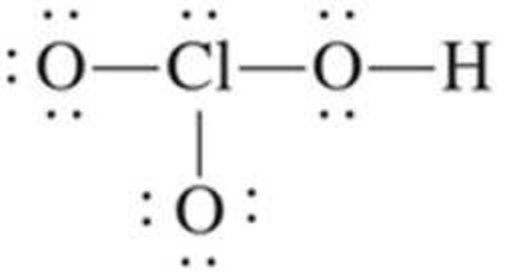
Bundle: General, Organic, and Biological Chemistry, 7th + OWLv2 Quick Prep for General Chemistry, 4 terms (24 months) Printed Access Card
7th Edition
ISBN: 9781305717534
Author: H. Stephen Stoker
Publisher: Cengage Learning
expand_more
expand_more
format_list_bulleted
Concept explainers
Textbook Question
Chapter 5, Problem 5.26EP
Identify the coordinate covalent bond(s) present, if any, in each of the following molecules by listing the two atoms involved in the bond. Name the atom on the left or the bottom in the bond first.




Expert Solution & Answer
Trending nowThis is a popular solution!

Chapter 5 Solutions
Bundle: General, Organic, and Biological Chemistry, 7th + OWLv2 Quick Prep for General Chemistry, 4 terms (24 months) Printed Access Card
Ch. 5.1 - Covalent bond formation most often involves...Ch. 5.1 - Which of the following concepts is closely...Ch. 5.1 - Prob. 3QQCh. 5.1 - Prob. 4QQCh. 5.2 - Prob. 1QQCh. 5.2 - Prob. 2QQCh. 5.2 - Prob. 3QQCh. 5.2 - Prob. 4QQCh. 5.2 - Prob. 5QQCh. 5.2 - Prob. 6QQ
Ch. 5.3 - Prob. 1QQCh. 5.3 - Prob. 2QQCh. 5.3 - Prob. 3QQCh. 5.3 - Prob. 4QQCh. 5.3 - Prob. 5QQCh. 5.4 - Prob. 1QQCh. 5.4 - Prob. 2QQCh. 5.4 - Prob. 3QQCh. 5.5 - Which of the following is an incorrect statement...Ch. 5.5 - Prob. 2QQCh. 5.5 - Prob. 3QQCh. 5.6 - Prob. 1QQCh. 5.6 - Prob. 2QQCh. 5.6 - Prob. 3QQCh. 5.6 - Prob. 4QQCh. 5.6 - Prob. 5QQCh. 5.7 - Prob. 1QQCh. 5.7 - Prob. 2QQCh. 5.7 - Prob. 3QQCh. 5.8 - Prob. 1QQCh. 5.8 - In VSEPR theory, an angular molecular geometry is...Ch. 5.8 - Prob. 3QQCh. 5.8 - Prob. 4QQCh. 5.8 - Prob. 5QQCh. 5.9 - Prob. 1QQCh. 5.9 - Prob. 2QQCh. 5.9 - Prob. 3QQCh. 5.9 - Prob. 4QQCh. 5.10 - Prob. 1QQCh. 5.10 - Prob. 2QQCh. 5.10 - Prob. 3QQCh. 5.10 - As the difference in electronegativity between two...Ch. 5.10 - Prob. 5QQCh. 5.10 - Prob. 6QQCh. 5.11 - Prob. 1QQCh. 5.11 - Prob. 2QQCh. 5.11 - Prob. 3QQCh. 5.11 - Prob. 4QQCh. 5.11 - Prob. 5QQCh. 5.12 - Prob. 1QQCh. 5.12 - Prob. 2QQCh. 5.12 - Prob. 3QQCh. 5.12 - Prob. 4QQCh. 5.12 - Prob. 5QQCh. 5.12 - Prob. 6QQCh. 5 - Contrast the types of elements involved in ionic...Ch. 5 - Contrast the mechanisms by which ionic and...Ch. 5 - Prob. 5.3EPCh. 5 - Prob. 5.4EPCh. 5 - Indicate whether or not covalent bond formation is...Ch. 5 - Indicate whether or not covalent bond formation is...Ch. 5 - Draw Lewis structures to illustrate the covalent...Ch. 5 - Draw Lewis structures to illustrate the covalent...Ch. 5 - How many nonbonding electron pairs are present in...Ch. 5 - How many nonbonding electron pairs are present in...Ch. 5 - The component elements for four binary molecular...Ch. 5 - The component elements for four binary molecular...Ch. 5 - Specify the number of single, double, and triple...Ch. 5 - Specify the number of single, double, and triple...Ch. 5 - Convert each of the Lewis structures in Problem...Ch. 5 - Convert each of the Lewis structures in Problem...Ch. 5 - Prob. 5.17EPCh. 5 - Prob. 5.18EPCh. 5 - Prob. 5.19EPCh. 5 - Identify the Period 3 nonmetal that would normally...Ch. 5 - How many valence electrons do atoms possess that...Ch. 5 - Prob. 5.22EPCh. 5 - What aspect of the following Lewis structure...Ch. 5 - What aspect of the following Lewis structure...Ch. 5 - Identify the coordinate covalent bond(s) present,...Ch. 5 - Identify the coordinate covalent bond(s) present,...Ch. 5 - Without actually drawing the Lewis structure,...Ch. 5 - Without actually drawing the Lewis structure,...Ch. 5 - Prob. 5.29EPCh. 5 - Prob. 5.30EPCh. 5 - Draw the Lewis structure for each of the molecules...Ch. 5 - Draw the Lewis structure for each of the molecules...Ch. 5 - Draw Lewis structures to illustrate the bonding in...Ch. 5 - Draw Lewis structures to illustrate the bonding in...Ch. 5 - How many electron dots should appear in the Lewis...Ch. 5 - Prob. 5.36EPCh. 5 - Draw Lewis structures for the following polyatomic...Ch. 5 - Draw Lewis structures for the following polyatomic...Ch. 5 - Draw Lewis structures for the following compounds...Ch. 5 - Draw Lewis structures for the following compounds...Ch. 5 - Draw Lewis structures for the following molecules...Ch. 5 - Draw Lewis structures for the following molecules...Ch. 5 - In which of the following pairs of diatomic...Ch. 5 - In which of the following pairs of diatomic...Ch. 5 - Prob. 5.45EPCh. 5 - What is the molecular geometry associated with...Ch. 5 - Specify the molecular geometry of each of the...Ch. 5 - Specify the molecular geometry of each of the...Ch. 5 - Prob. 5.49EPCh. 5 - Prob. 5.50EPCh. 5 - Prob. 5.51EPCh. 5 - Prob. 5.52EPCh. 5 - Prob. 5.53EPCh. 5 - Prob. 5.54EPCh. 5 - Using VSEPR theory, predict the molecular geometry...Ch. 5 - Using VSEPR theory, predict the molecular geometry...Ch. 5 - Prob. 5.57EPCh. 5 - Specify both the VSEPR electron group geometry...Ch. 5 - Prob. 5.59EPCh. 5 - Prob. 5.60EPCh. 5 - Using a periodic table, but not a table of...Ch. 5 - Using a periodic table, but not a table of...Ch. 5 - Prob. 5.63EPCh. 5 - Prob. 5.64EPCh. 5 - Place + above the atom that is relatively positive...Ch. 5 - Place + above the atom that is relatively positive...Ch. 5 - Rank the following bonds in order of increasing...Ch. 5 - Rank the following bonds in order of increasing...Ch. 5 - Classify each of the following bonds as nonpolar...Ch. 5 - Classify each of the following bonds as nonpolar...Ch. 5 - Prob. 5.71EPCh. 5 - Prob. 5.72EPCh. 5 - Fill in the blanks in each line of the following...Ch. 5 - Fill in the blanks in each line of the following...Ch. 5 - Four hypothetical elements, A, B, C, and D, have...Ch. 5 - Four hypothetical elements, A, B, C, and D, have...Ch. 5 - Indicate whether each of the following...Ch. 5 - Prob. 5.78EPCh. 5 - Indicate whether each of the following triatomic...Ch. 5 - Indicate whether each of the following triatomic...Ch. 5 - Indicate whether each of the following molecules...Ch. 5 - Indicate whether each of the following molecules...Ch. 5 - Prob. 5.83EPCh. 5 - Prob. 5.84EPCh. 5 - Indicate which molecule in each of the following...Ch. 5 - Indicate which molecule in each of the following...Ch. 5 - Successive substitution of F atoms for H atoms in...Ch. 5 - Successive substitution of F atoms for H atoms in...Ch. 5 - Prob. 5.89EPCh. 5 - Indicate whether or not each of the following...Ch. 5 - Prob. 5.91EPCh. 5 - Name the following binary molecular compounds? a....Ch. 5 - Prob. 5.93EPCh. 5 - Prob. 5.94EPCh. 5 - Prob. 5.95EPCh. 5 - Prob. 5.96EPCh. 5 - Prob. 5.97EPCh. 5 - Prob. 5.98EPCh. 5 - Write chemical formulas for the following binary...Ch. 5 - Write chemical formulas for the following binary...Ch. 5 - Prob. 5.101EPCh. 5 - Prob. 5.102EPCh. 5 - The compound whose molecles contain one atom of C...Ch. 5 - Prob. 5.104EPCh. 5 - Prob. 5.105EPCh. 5 - The correct name for the compound K2SO4 is not...Ch. 5 - Prob. 5.107EPCh. 5 - Prob. 5.108EP
Knowledge Booster
Learn more about
Need a deep-dive on the concept behind this application? Look no further. Learn more about this topic, chemistry and related others by exploring similar questions and additional content below.Similar questions
- What is the most polar bond in the molecule?arrow_forwardWhich one of the following bonds is polar? a. a bond between two identical atoms b. a bond between two atoms with the same electronegativity c. a bond between two atoms with different electronegativitiesarrow_forwardUse the Molecule Shape simulator (http://openstaxcollege.org/I/6MolecShape) to build a molecule. Starting with the central atom, click on the double bond to add one double bond. Then add one single bond and one lone pair. Rotate the molecule to observe the complete geometry. Name the electron group geometry and molecular structure and predict the bond angle. Then click the check boxes at the bottom and right of the simulator to check your answers.arrow_forward
- Methylcyanoacrylate is the active ingredient in super glues. Its Lewis structure is In this molecule, which is the (a) weakest carbon-containing bond? (b) strongest carbon-containing bond? (c) most polar bond?arrow_forwardThe component elements for four binary molecular compounds are shown with different colors on the following periodic table. What is the chemical formula for the simplest compound likely to be formed in each case? a. Red compound b. Blue compound c. Yellow compound d. Green compoundarrow_forwardExplain the difference between electron-pair geometry and molecular structure.arrow_forward
arrow_back_ios
arrow_forward_ios
Recommended textbooks for you
 General, Organic, and Biological ChemistryChemistryISBN:9781285853918Author:H. Stephen StokerPublisher:Cengage Learning
General, Organic, and Biological ChemistryChemistryISBN:9781285853918Author:H. Stephen StokerPublisher:Cengage Learning World of Chemistry, 3rd editionChemistryISBN:9781133109655Author:Steven S. Zumdahl, Susan L. Zumdahl, Donald J. DeCostePublisher:Brooks / Cole / Cengage Learning
World of Chemistry, 3rd editionChemistryISBN:9781133109655Author:Steven S. Zumdahl, Susan L. Zumdahl, Donald J. DeCostePublisher:Brooks / Cole / Cengage Learning Chemistry for Today: General, Organic, and Bioche...ChemistryISBN:9781305960060Author:Spencer L. Seager, Michael R. Slabaugh, Maren S. HansenPublisher:Cengage Learning
Chemistry for Today: General, Organic, and Bioche...ChemistryISBN:9781305960060Author:Spencer L. Seager, Michael R. Slabaugh, Maren S. HansenPublisher:Cengage Learning Introductory Chemistry: An Active Learning Approa...ChemistryISBN:9781305079250Author:Mark S. Cracolice, Ed PetersPublisher:Cengage Learning
Introductory Chemistry: An Active Learning Approa...ChemistryISBN:9781305079250Author:Mark S. Cracolice, Ed PetersPublisher:Cengage Learning Living By Chemistry: First Edition TextbookChemistryISBN:9781559539418Author:Angelica StacyPublisher:MAC HIGHER
Living By Chemistry: First Edition TextbookChemistryISBN:9781559539418Author:Angelica StacyPublisher:MAC HIGHER

General, Organic, and Biological Chemistry
Chemistry
ISBN:9781285853918
Author:H. Stephen Stoker
Publisher:Cengage Learning

World of Chemistry, 3rd edition
Chemistry
ISBN:9781133109655
Author:Steven S. Zumdahl, Susan L. Zumdahl, Donald J. DeCoste
Publisher:Brooks / Cole / Cengage Learning


Chemistry for Today: General, Organic, and Bioche...
Chemistry
ISBN:9781305960060
Author:Spencer L. Seager, Michael R. Slabaugh, Maren S. Hansen
Publisher:Cengage Learning

Introductory Chemistry: An Active Learning Approa...
Chemistry
ISBN:9781305079250
Author:Mark S. Cracolice, Ed Peters
Publisher:Cengage Learning

Living By Chemistry: First Edition Textbook
Chemistry
ISBN:9781559539418
Author:Angelica Stacy
Publisher:MAC HIGHER
Types of bonds; Author: Edspira;https://www.youtube.com/watch?v=Jj0V01Arebk;License: Standard YouTube License, CC-BY